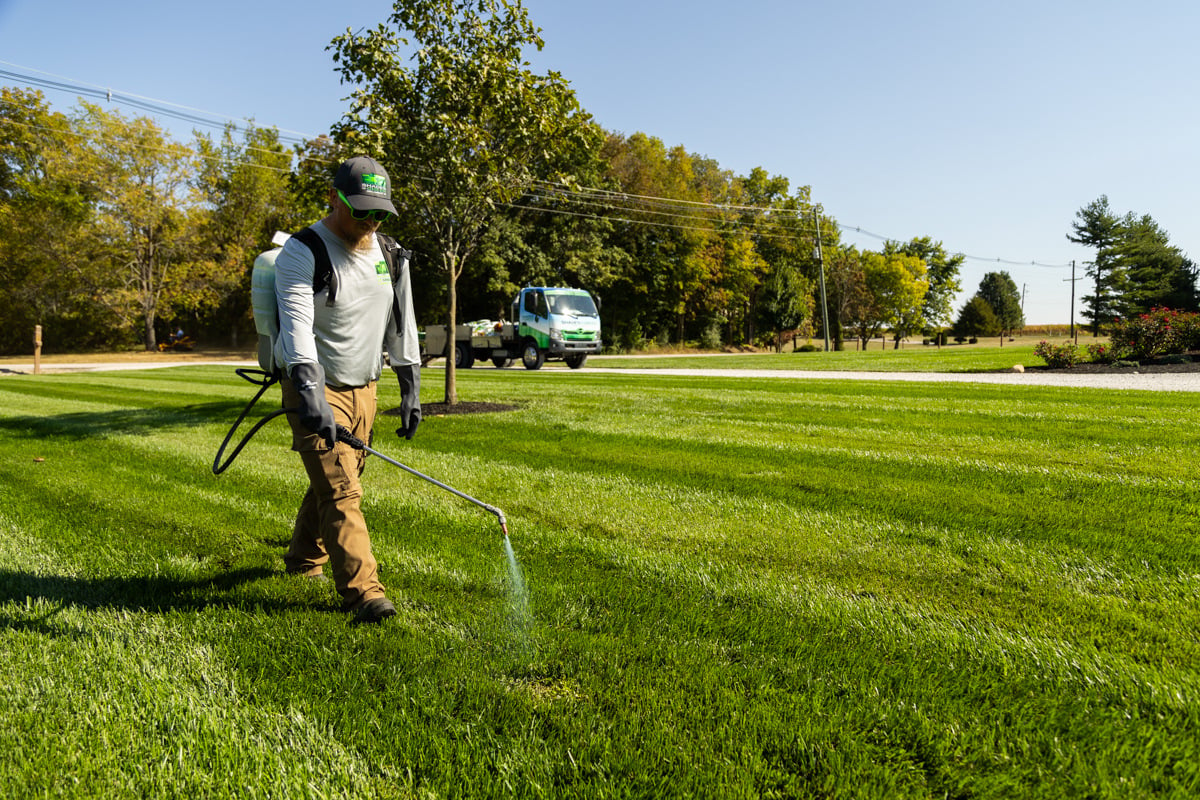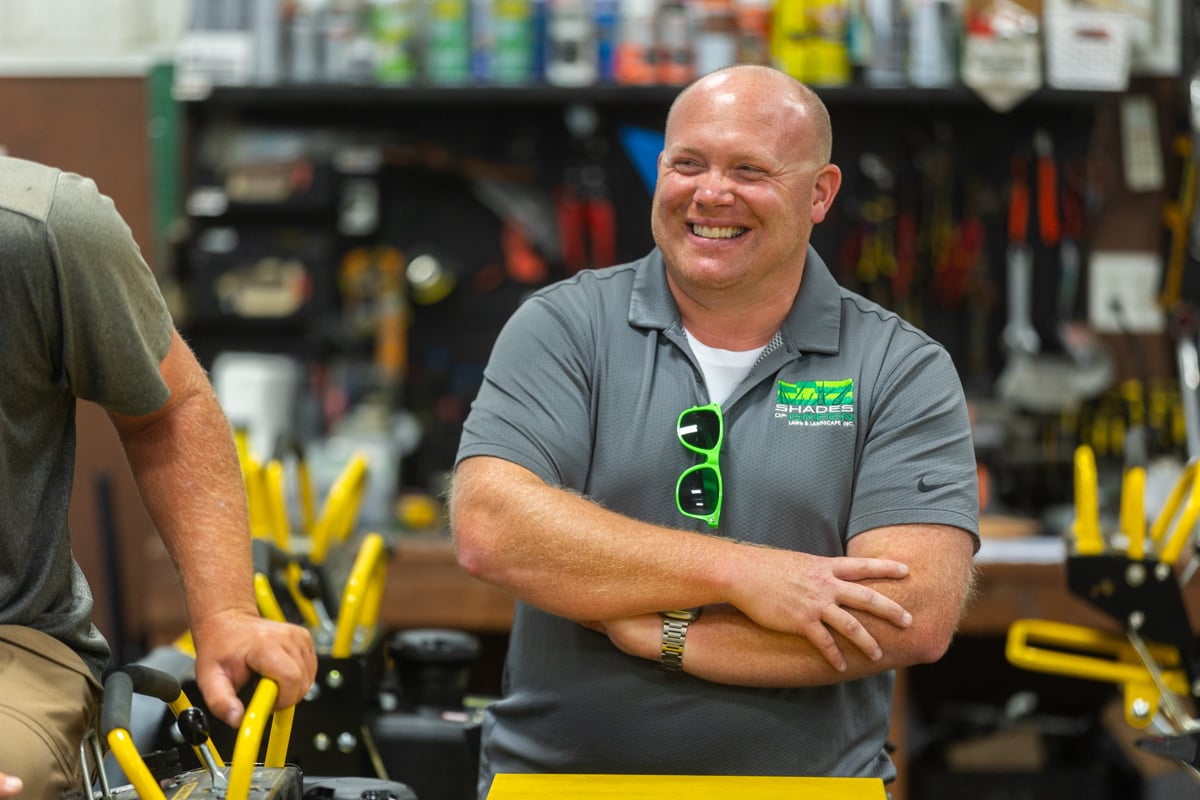
Say Goodbye to Weeds: When to Apply Weed Control in Indiana

Let’s face it – Indiana lawns are prime real estate for some truly annoying guests. No, not your neighbor’s wandering dog. We’re talking about weeds.
Dandelions, clover, crabgrass, yellow nutsedge, and more are the freeloaders of the lawn world, and they have got to go. If you’re dreaming of a lush, green lawn where weeds don’t crash the party, the secret lies in timing your weed control treatments just right. In this blog, we’ll break down the essentials of weed control: what it is, how it works, and most importantly when to apply it. We’ll also dive into the two main strategies for tackling weeds – pre-emergent and post-emergent weed control – so you can show those pesky plants who’s boss.
In this blog, we’ll break down the essentials of weed control: what it is, how it works, and most importantly when to apply it. We’ll also dive into the two main strategies for tackling weeds – pre-emergent and post-emergent weed control – so you can show those pesky plants who’s boss.
What is Weed Control?
Weed control is all about keeping unwanted plants (aka weeds) out so your grass can thrive. Weeds compete with your turf for sunlight, water, and nutrients, leaving your grass looking patchy, stressed, and sad. The trick to winning the war on weeds is understanding how they grow and matching the right lawn weed treatments to their life stage. That’s where pre-emergent and post-emergent treatments come into play.
The trick to winning the war on weeds is understanding how they grow and matching the right lawn weed treatments to their life stage. That’s where pre-emergent and post-emergent treatments come into play.
Pre-Emergent Weed Control
Pre-emergent weed control is your lawn’s first line of defense. Think of it like putting a force field over your soil to prevent weed seeds from sprouting. Pre-emergent doesn’t kill weeds that are already growing; they stop new ones from ever seeing the light of day.
Weeds That Need Pre-Emergent Control:
Crabgrass
Crabgrass thrives in bare or thin patches of your yard, especially in sunny areas. Once it germinates, crabgrass grows fast and spreads like wildfire, choking out your grass and making your lawn look like a patchy mess. Pre-emergent weed control is essential because crabgrass is best dealt with before it has even had a chance to germinate. Once it starts growing, it becomes much harder to manage, often requiring specialized post-emergent products, which can become costly.
Yellow Nutsedge
Yellow nutsedge is a stubborn perennial weed that pops up year after year. It thrives in wet or poorly drained soil and grows faster than your lawn grass. The real problem with yellow nutsedge is its underground tubers, called nutlets, which lead to hundreds of new plants each year. Pre-emergent weed control can help by targeting the seeds before they germinate, stopping the next generation of nutsedge before it starts. While post-emergent treatments may be needed for existing plants, pre-emergent reduces the likelihood of future outbreaks.
Post-Emergent Weed Control
While pre-emergent keeps the weeds from invading in the first place, post-emergent is like the cleanup crew. These treatments target weeds that are already growing and make quick work of them.
Weeds that Need Post-Emergent Control:
Dandelions
This broadleaf weed with deep taproots makes them particularly tricky to remove. Post-emergent treatments are your best bet for dealing with dandelions because they work by targeting the leaves and killing the entire plant, including that stubborn taproot.
Clover
Clover might seem like a harmless ground cover, but it’s a sneaky competitor for your grass, soaking up nutrients your lawn needs to thrive. Post-emergent herbicides are effective for clover because they target the plant while it’s growing, disrupting its ability to steal nutrients and reproduce. Clover often thrives in lawns that are low in nitrogen, so addressing the underlying nutrient imbalance can also help in the long run.
Thistle
Thistle is one of the most frustrating weeds in Indiana – spiky and hard to get rid of. Thistle plants have deep, extensive root systems that require targeted control. Post-emergent herbicides are necessary to kill the entire plant, roots, and all.  A good lawn care plan includes both pre-emergent prevention and post-emergent solutions.
A good lawn care plan includes both pre-emergent prevention and post-emergent solutions.
When to Spray for Lawn Weeds in Indiana
Unfortunately, there is no one best time to spray for weeds in Indiana; there’s no magical date to mark on your calendar. The timing depends on several factors, like the type of weed you’re targeting, the weather, and even your lawn’s unique needs. In short, the “right” time to spray depends on what you’re dealing with and the conditions at hand. Keeping an eye on your lawn, staying flexible, and targeting weeds when they’re most vulnerable are the real keys to success.
Best Time to Spray Weed Killer in Indiana: When to Spray Pre-Emergent Weed Control
Pre-emergent weed control works by creating a barrier in the soil that stops weed seeds from germinating. But to work effectively, it needs to bind to the soil first and that’s where weather and timing come into play.
In Indiana, spring tends to bring heavy rains that can leave the ground soggy. If you apply pre-emergent to waterlogged soil, it might not bind properly and could even wash away with runoff. That’s a lot of wasted effort, product, and money. At Shades of Green, we have shifted pre-emergent applications to the fall in order to avoid the chaos of spring. Fall is ideal because the soil is drier, making it easier to maneuver equipment without damaging the lawn. Pre-emergent applied in the fall can settle into the soil and stay dormant through the winter, thanks to low microbial activity during cold months. When spring arrives and the soil warms up, the pre-emergent activates just in time to block pesky invaders like crabgrass and yellow nutsedge.
At Shades of Green, we have shifted pre-emergent applications to the fall in order to avoid the chaos of spring. Fall is ideal because the soil is drier, making it easier to maneuver equipment without damaging the lawn. Pre-emergent applied in the fall can settle into the soil and stay dormant through the winter, thanks to low microbial activity during cold months. When spring arrives and the soil warms up, the pre-emergent activates just in time to block pesky invaders like crabgrass and yellow nutsedge.
For added protection, especially on properties with tough weed problems, we often recommend two applications per year: one in the fall and one in the early spring. This double-duty approach ensures continuous weed defense and gives your lawn a fighting chance against Indiana’s most notorious weeds.
For smaller lawns or areas where equipment access isn’t an issue, applying pre-emergent in March or early spring is a viable option. However, timing is critical — too early, and the product might break down before weeds start germinating; too late, and those weeds might already be making themselves at home. And don’t forget those spring rains — if the ground is too wet, you risk compacting the soil with equipment or having the product wash away.
Best Time to Spray Weed Killer in Indiana: When to Spray Post-Emergent Weed Control
Post-emergent weed control doesn’t follow a strict calendar like pre-emergent – it’s all about observing your lawn and striking when weeds are active and vulnerable. Timing varies depending on the weed type and its growth stage.
When it comes to post-emergent treatments, not all products are created equal. There are two main classes commonly used for weed control, and each has its sweet spot.
Class 1: Early Season Efficiency
The first class works beautifully in cooler soil temperatures and is most effective against yellow nutsedge until about mid-June. This option is relatively affordable compared to later treatments, but once the nutlets start forming, it’s game over for this product – it just can’t keep up.
Class 2: Late-Season Power
After mid-June, when yellow nutsedge becomes a tougher customer, we switch to the second chemical class. These treatments are slower to act but more thorough, making them the go-to option for tougher weeds that have dug in. However, they come at a premium, costing about double compared to early season treatments.
Partnering with Shades of Green for Weed Control in Lafayette and North Indianapolis Suburbs
Weeds are a relentless foe for Indiana homeowners, turning dreams of lush, green lawns into a constant battle. From dandelions to crabgrass, each type of weed presents unique challenges.
A successful lawn weed treatment plan involves both pre-emergent treatments to stop weeds before they start and post-emergent solutions to tackle those already thriving.
DIY weed control often leads to frustration, wasted time, and costly mistakes. That’s why partnering with a pro is the wise choice for homeowners ready to reclaim their lawns.
With expertise, customized treatments, and a deep understanding of Indiana’s toughest weeds, Shades of Green ensures your lawn remains a source of pride - not stress.
If you’re ready to defeat weeds for good, get started on your picture perfect lawn today by filling out our contact form. We provide lawn care services in Lafayette, IN, along with in Carmel, Noblesville, & Westfield.
Image Sources: clover, crabgrass, yellow nutsedge, thistle
About Cory Overman

Cory is the heart and soul of Shades of Green. His dedication to doing right for our customers has been the driving force behind the company's success. With a degree in Turf Science from Purdue University, Cory continually strives to craft the best treatment plans using the latest technologies and innovative products, ensuring top-notch results for every client.

